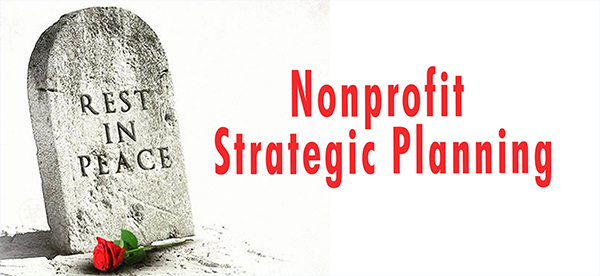
Ava Kaufman Has the Heart of a 17 Year Old Boy
November 6, 2019Top 5 Essentials for Your Nonprofit Website
November 9, 2019Nonprofit Strategic Planning is Dead – Jimmy LaRose

Nonprofit Strategic Planning is Dead! Quit it, Stop Wasting Your Time. Old thinking prevents CEOs from achieving their important mission. Here’s what stopped working 25 years ago:
#1 SWOT Analysis – Failed & Archaic (OH MY LORD…PLEASE END IT NOW!)
#2 Board Retreats – Cocktails on Friday Evening (everyone’s gone before 12:00pm on Saturday)
#3 Visioning – “Who Do We Want to Be When We Grow Up?” The question is a adolescent.
#4 Money Is No Object – “If we had all the money we needed what would we achieve?”
YOU’LL NEVER GROW YOUR MISSION BY EMBRACING OUTDATED FRAMEWORKS.
Consultants attempt to sell you a product that INVOLVES YOUR BOARD IN NONPROFIT STRATEGIC PLANNING. Here’s the problem. You are the STRONG CEO. You know more about your organization than a board member ever will. Why?
#1 Have Your Directors Ever Managed a Nonprofit? NO
#2 Have Your Directors Ever Served Your Population? NO
#3 Have Your Directors Ever Raised Monies For The People You Serve? NO
Why then would you allow them to be involved in strategic planning? Allow me to share with you an spectacular alternative:
ORGANIZATIONAL DEVELOPMENT! OD, OD, OD!
NONPROFIT STRATEGIC PLANNING vs. ORGANIZATIONAL DEVELOPMENT
Organizational Development (OD) is a planned, systematic and comprehensive effort to increase a nonprofit’s performance, sustainability and relevancy. An OD initiative, if done properly, brings focus and momentum that will move any nonprofit to the next level of success. It is an intentional effort to change an organization to achieve a specific, pre-determined, end result leading to greater success for the nonprofit, its staff, board, volunteers, and community served. In a nutshell, OD ensures that a nonprofit is worthy of asking donor’s for support through an intentional effort to be good stewards of their investment (doing the right things) and to always be exploring the most effective way (doing things right) with the dollars they give. By the end of the process you’ll know how much money you need over what period of time AND for what? (Read Louis Fawcett’s PUTTING MONEY FIRST to find out why this is key.) The following list broadly overviews three important elements of an OD process.
OD – Step #1 – Organizational Assessment…to gain an accurate picture of the nonprofit’s “AS IS” state
OD – Step #2 – Organizational Planning…to gain a clear picture of the nonprofit’s desired “TO BE” state
OD – Step #3 – Change Management Plan…to close the gap between “AS IS & TO BE!”
Here are the institution-wide themes you’ll have to evaluate:
Leadership (Time & Money)
Modeling Values, Managing Relationships, Mastering Change
Operations (Time & Money)
Programs & Revenue, Organizational Structures, Policies & Procedures
Staff (Time & Money)
Knowledge, Skills, Abilities
Environment (Time & Money)
Attitudes, Perceptions, Relationships
Technology (Time & Money)
-Software Systems, Hardware Systems, Online Strategies
Which one of your board members is going to take the time to evaluate these areas, determine costs, forecast outcomes and the write a change management plan that ensures they’re implemented? NONE OF YOUR BOARD MEMBERS ARE CAPABLE OF THIS KEY RESPONSIBILITY. Stop deceiving your board into thinking they’re part of nonprofit strategic planning and replace it with CEO driven organizational development.
Here’s What CEO Driven Organizational Development Will Accomplish:
a. You will build more capacity than those charities who continue to rely on nonprofit strategic planning.
b. You will grow your budget, programs & donors, despite the recession.
c. You will grow your organization regardless of the size or involvement of their board.
d. You will externalized your mission of their organization for the purpose of fundraising.
e. You will develop board members who promote your vision NOT THE BOARDS.
The greatest contribution we can make to the nonprofit sector is to challenge boards to do whatever it takes to attract, pay and empower great CEOs. Let the CEO perform OD. Let the CEO bring a great dream backed by a sound plan to the board for their endorsement. At the end of the day it’s the CEO who has to implement the “changement plan” NOT THE BOARD. Let the CEO take your breath away by sharing with board members a heroic mission of scale that deals with a problem so completely that money chases after it.
In closing, shift your thinking and make sure the highest paid employee (CEO) is responsible to develop an institution-wide organizational plan that will achieve your mission in ways you never dreamed possible.
Nonprofit Strategic Planning is Dead was written by author, speaker and nonprofit fundraiser Jimmy LaRose. To learn more about Organizational Development please review New Guidelines for Nonprofits. New Guidelines are located in the National Association of Nonprofit Organizations & Executives’ Capacity-Building Library.
The post Nonprofit Strategic Planning is Dead – Jimmy LaRose appeared first on NANOE | Charity’s Official Website.
